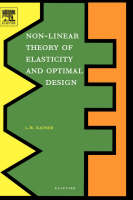
Non-Linear Theory of Elasticity and Optimal Design
Elsevier Science Ltd (Verlag)
978-0-444-51427-1 (ISBN)
- Titel ist leider vergriffen;
keine Neuauflage - Artikel merken
In order to select an optimal structure among possible similar structures, one needs to compare the elastic behavior of the structures. A new criterion that describes elastic behavior is the rate of change of deformation. Using this criterion, the safe dimensions of a structure that are required by the stress distributed in a structure can be calculated. The new non-linear theory of elasticity allows one to determine the actual individual limit of elasticity/failure of a structure using a simple non-destructive method of measurement of deformation on the model of a structure while presently it can be done only with a destructive test for each structure. For building and explaining the theory, a new logical structure was introduced as the basis of the theory. One of the important physical implications of this logic is that it describes mathematically the universal domain of the possible stable physical relations.
Introduction.Prologue.PART I.Developing the reliable theory for optimal structure. The practical problems. Foundation of Non-Linear Theory of Elasticity. Comparative analysis of the linear and non-linear theories.Devising Non-linear Theory of Elasticity. Principles of Logic in NLTE. Method of Optimal Structural Design. On Mathematics in Physics. On The Nature of Limit of Elasticity. On The Nature of Proof in Physical Theory. History of Theory of Elasticity. On The Principles of Non-Linear Theory. Appendix I. Method of and Apparatus for Optimization of Structures (US Patent Specification).Notations. PART II.Linear theory of infinitesimal deformations.The principles of LTE. Stress. Deformation. Hooke's law. Geometric characteristics. Combination of stresses. PART III.Optimization of the typical structures.Introduction. Tension/Compression. Torsion. Bending. Combined Stresses. Continuous Beams. Elastic Stability of Thin Shells. Elastic Stability of Plates. Dynamic Stresses. Testing Materials. Appendix II. Tables for Optimal Design of the Typical Beams. Tables for Optimal Design of Shafts. Tables for Optimal Design of Plates. PART IV.Further discussions in the theory of elasticity.Graph Analysis. Geometrical Models of Physical Functions. The Equation of Elastic Line and NLTE. Part V. Philosophy and Logic of Physical Theory. Philosophical Background of the Non-Linear Theory of Elasticity. Logic and Physical Theory.Role of logic in science.General argument.The rules of logic.Logic of construction Non-Linear Theory of Elasticity.The definitive logic.It is possible to prove a physical theory.Notes on Logic. The commentaries on "Preface to Logic" by Morris R. Cohen.The commentaries on "An Introduction to the Philosophy of Science" by Rudolf Carnap.Definition of Scientific Law.Induction.Concepts in Science.Measurement.Geometry and a theory. Kant's synthetic a priori.Notes on methodology of science.On nature of a scientific theory.The theory of elasticity as an organized knowledge.Flow-Chart Diagram.Logical structure of Non-Linear Theory of Elasticity.Logic in mathematics.On explanation of a physical theory.Inferential conception of explanation.The causal conception of scientific explanation.Theory and observation.Validation of scientific theory. Justificationism.Falsificationism.Conventionalism.The testing paradigm of scientific inference.In summary.On the logic of truth-function.On the logic of classes.Conclusion.Bibliography.Subject Index.
| Erscheint lt. Verlag | 12.11.2003 |
|---|---|
| Verlagsort | Oxford |
| Sprache | englisch |
| Maße | 156 x 234 mm |
| Gewicht | 580 g |
| Themenwelt | Technik ► Maschinenbau |
| ISBN-10 | 0-444-51427-9 / 0444514279 |
| ISBN-13 | 978-0-444-51427-1 / 9780444514271 |
| Zustand | Neuware |
| Haben Sie eine Frage zum Produkt? |
aus dem Bereich


